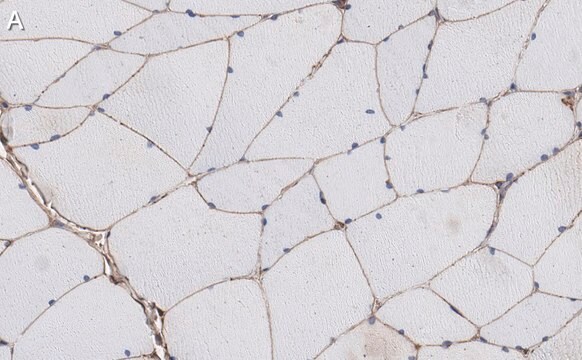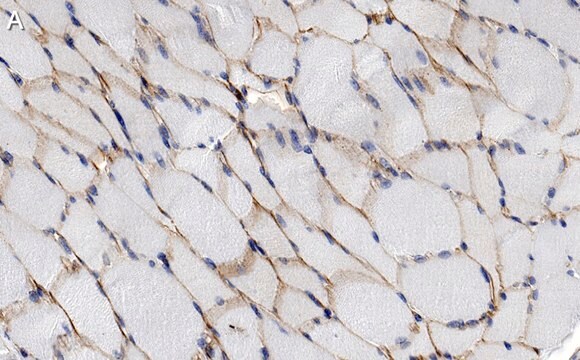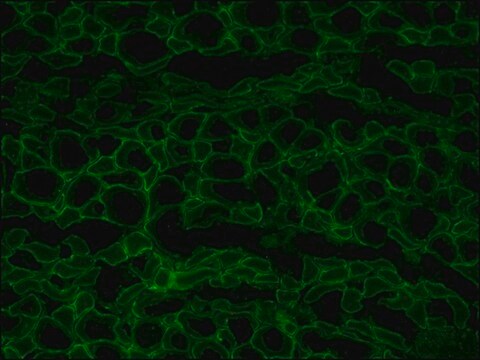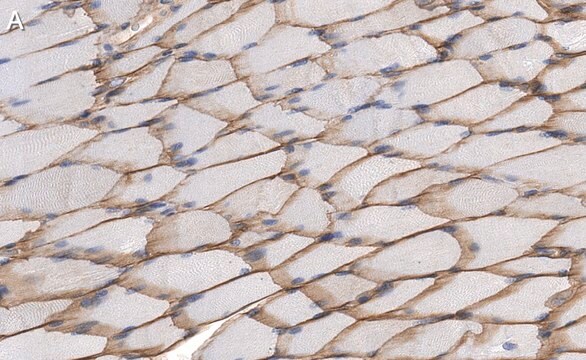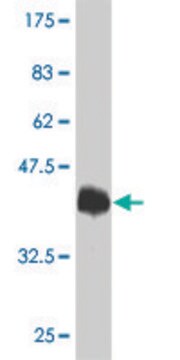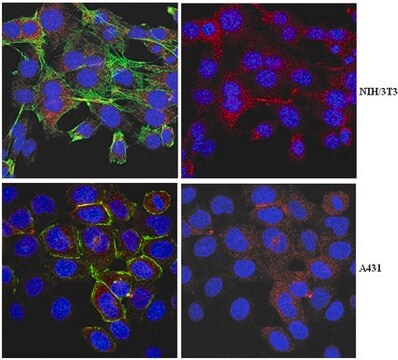05-593-I
Anti-α-Dystroglycan Antibody
Sinonimo/i:
Dystroglycan antibody
About This Item
Prodotti consigliati
Origine biologica
mouse
Livello qualitativo
Coniugato
unconjugated
Forma dell’anticorpo
purified antibody
Tipo di anticorpo
primary antibodies
Clone
IIH6 (or IIH6C4), monoclonal
PM
calculated mol wt 97.03 kDa
observed mol wt ~43 and 156 kDa
Reattività contro le specie
rabbit, human, mouse
Reattività contro le specie (prevista in base all’omologia)
guinea pig, canine, rat
Confezionamento
antibody small pack of 100 μL
Isotipo
IgM
N° accesso UniProt
Condizioni di spedizione
dry ice
Temperatura di conservazione
-10 to -25°C
modifica post-traduzionali bersaglio
unmodified
Informazioni sul gene
rabbit ... DAG1(100009278)
Descrizione generale
Specificità
Immunogeno
Applicazioni
Evaluated by Western Blotting in Rabbit skeletal muscle tissue lysate.
Western Blotting Analysis: 1:1,000 of this antibody detected Dystroglycan in Rabbit skeletal muscle tissue lysate.
Tested Applications
Western Blotting Analysis: A representative lot detected Dystroglycan in Western Blotting applications (Azzag, K., et. al. (2020). Skelet Muscle. 10(1):10 ; Bijata, M., et. al. (2015). Front Cell Neurosci. 9:199).
Immunohistochemistry (Paraffin) Analysis: A 1:50 dilution from a representative lot detected Dystroglycan in mouse heart and mouse skeletal muscle tissue sections.
Flow Cytometry Analysis: A representative lot detected Dystroglycan in Flow Cytometry applications (Gerin, I., et. al. (2016). Nat Commun. 7:11534).
Immunofluorescence Analysis: A representative lot detected Dystroglycan in Immunofluorescence applications (Azzag, K., et. al. (2020). Skelet Muscle. 10(1):10).
Inhibition Analysis: A representative lot reduced agrin-induced ERK activation in cardiac cells. (Bassat, E., et. al. (2017). Nature. 547(7662):179-184)
Immunohistochemistry Applications: A representative lot detected -Dystroglycan in Immunohistochemistry applications (Cataldi, M.P., et. al. (2018). Nat Commun. 9(1):3448).
Immunocytochemistry Analysis: A representative lot detected Dystroglycan in Immunocytochemistry applications (Bijata, M., et. al. (2015). Front Cell Neurosci. 9:199).
Note: Actual optimal working dilutions must be determined by end user as specimens, and experimental conditions may vary with the end user
Stato fisico
Stoccaggio e stabilità
Altre note
Esclusione di responsabilità
Non trovi il prodotto giusto?
Prova il nostro Motore di ricerca dei prodotti.
Raccomandato
Codice della classe di stoccaggio
10 - Combustible liquids
Classe di pericolosità dell'acqua (WGK)
WGK 1
Punto d’infiammabilità (°F)
Not applicable
Punto d’infiammabilità (°C)
Not applicable
Certificati d'analisi (COA)
Cerca il Certificati d'analisi (COA) digitando il numero di lotto/batch corrispondente. I numeri di lotto o di batch sono stampati sull'etichetta dei prodotti dopo la parola ‘Lotto’ o ‘Batch’.
Possiedi già questo prodotto?
I documenti relativi ai prodotti acquistati recentemente sono disponibili nell’Archivio dei documenti.
Il team dei nostri ricercatori vanta grande esperienza in tutte le aree della ricerca quali Life Science, scienza dei materiali, sintesi chimica, cromatografia, discipline analitiche, ecc..
Contatta l'Assistenza Tecnica.